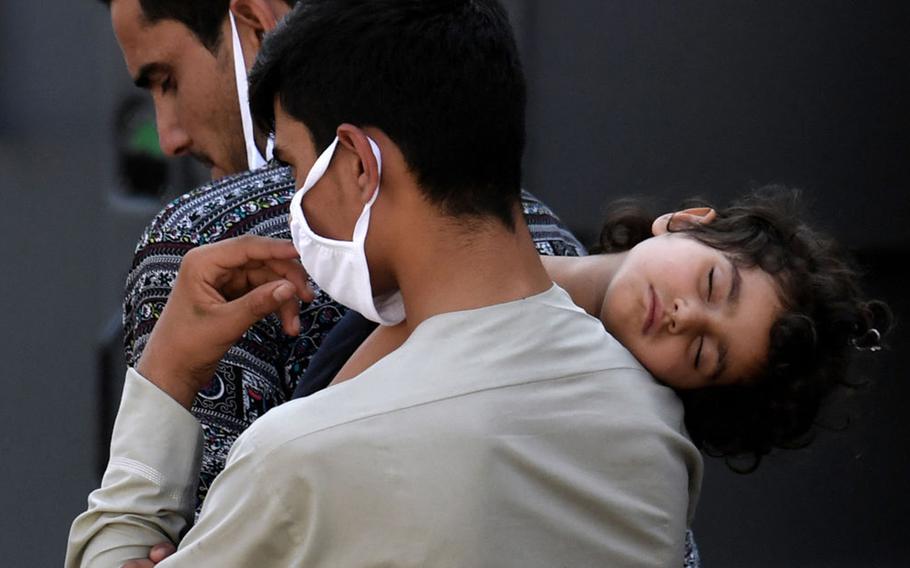
Afghan refugees arrive at a processing center in Chantilly, Va., on Aug. 23, 2021, after arriving on a flight at Dulles International Airport. (Olivier Douliery, AFP via Getty Images/TNS)
(Tribune News Service) — Only a fraction of the tens of thousands of Afghan refugees who have arrived in the United States in recent months have been resettled into American communities, while the vast majority remain on U.S. military bases.
But an infusion of $6.3 billion in government funds, allocated in the stopgap spending bill signed into law Sept. 30, could provide a much-needed boost to the resettlement effort. The additional funding authority may help clear problems stemming from a combination of mandatory medical quarantines, scarce resources and sheer volume of people in need.
Only around 7,000 of the Afghans who have arrived in the U.S. after the Taliban takeover have been “matched with resettlement agencies and affiliates to join communities in 46 states across the country where they will receive initial relocation services,” a State Department spokesperson said last week.
But most of the evacuees — more than 53,000 — continue to wait at one of eight domestic U.S. military bases, with an additional 15,000 being vetted at overseas sites before they can enter the country, according to the Department of Homeland Security.
As increasing numbers of people arrived at U.S. bases from overseas “lily pad” locations, without equal numbers of people leaving to be resettled, populations at the bases expanded, straining resources.
The Department of Defense received $2.2 billion in the stopgap bill for Afghans at military installations, where they undergo collection of biometrics, medical screenings, file for employment authorization and work with resettlement groups to determine their final destination in the U.S.
“More and more people were arriving at the military bases, and we weren’t moving them to their local sites,” said Meredith Owen, director of policy and advocacy at the resettlement group Church World Service. “So the population at the bases got a lot bigger. And then it takes longer to do processing.”
A key provision in the stopgap bill made Afghans who entered the country under humanitarian parole, which allows temporary U.S. stays without visas, eligible for the same benefits as traditional refugees, including assistance with housing, employment placement and training, and medical care.
Advocates say that expanded eligibility for refugee benefits will make it easier to meet the needs of parolees and help them begin their life in the U.S.
“Resettlement sites were being asked to do a lot of resettlement services without too many additional resources to do the work,” Owen said. “We were able to leverage as many volunteers as we can, but the additional resources can go a long way towards stabilizing capacity.”
The bill also provided $1.7 billion to the Administration for Children and Families, within the Health and Human Services Department, which provides funding to states and resettlement agencies for refugee-related expenses, such as reimbursing state Medicaid programs for medical care.
“We are working closely with our resettlement agency partners to build capacity to provide these initial relocation services to newly arriving Afghans in their communities,” the State Department spokesperson said.
The stopgap spending bill included $21.5 million for the Centers for Disease Control and Prevention for medical screening and support for Afghans, which could bolster the response to a handful of measles cases among evacuees that led to widespread vaccinations against the disease.
The CDC now requires a three-week quarantine period for Afghan evacuees after receiving the vaccination for measles, mumps and rubella, so that the vaccine can take effect, keeping many people on military bases until that time period is up.
“My expectation would be that as the quarantine periods end, that there should be significant numbers of people moving from military bases to communities,” said Mark Greenberg, a senior fellow at the nonpartisan Migration Policy Institute and former top official at the Administration for Children and Families.
A weaker refugee resettlement infrastructure also has made it difficult to resettle large numbers of refugees, advocates say. During the Trump administration, refugee admissions sharply declined, leading the government agencies and nonprofit organizations involved in resettlement to draw back their resources.
“There are still challenges for resettlement agencies, because during the Trump administration, the resettlement agencies lost staff and had to close offices and suspend processing,” Greenberg said. “And now the arriving evacuees are large numbers in relation to the numbers of refugees they have been working with in recent years.”
©2021 CQ-Roll Call, Inc., All Rights Reserved.
Visit cqrollcall.com.
Distributed by Tribune Content Agency, LLC.